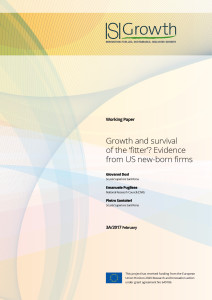We examine market selection mechanisms and their strength for a representative cohort of US new independent firms. In particular, we explore whether and how effectively markets reward newly-born firms according to their ‘fitness’ in terms of both labour productivity and profitability. Our analysis yields puzzling results in contrast with canonical industry dynamics models. First, we find that selection on differential growth is mainly related to productivity while profitability plays a negligible role. Second, in contrast with the growth of the fitter principle, selection appears to be driven by changes in firms’ relative productivity. Third, we explore how new firms’ relative fitness affects their growth performance in different sectors. Our results reveal that market selection operates quite differently across them with higher incidence for new-born firms in services, low-tech and less
concentrated sectors. Fourth, concerning selection via exit, our results support the survival of the fitter principle with respect to productivity, while relative profitability does not seem to exert any significant effect on survival probabilities. However, the contribution of firm relative ‘fitness’ to the total firm exit rates variation appears to be modest.
Growth and survival of the ‘fitter’? Evidence from US new-born firms
Giovanni Dosi
Scuola Superiore Sant’Anna
Emanuele Pugliese
National Reseacrh Council (CNR)
Pietro Santoleri
Scuola Superiore Sant’Anna

